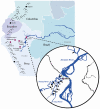A large proportion of P. falciparum isolates in the Amazon region of Peru lack pfhrp2 and pfhrp3: implications for malaria rapid diagnostic tests
- PMID: 20111602
- PMCID: PMC2810332
- DOI: 10.1371/journal.pone.0008091
A large proportion of P. falciparum isolates in the Amazon region of Peru lack pfhrp2 and pfhrp3: implications for malaria rapid diagnostic tests
Abstract
Background: Malaria rapid diagnostic tests (RDTs) offer significant potential to improve the diagnosis of malaria, and are playing an increasing role in malaria case management, control and elimination. Peru, along with other South American countries, is moving to introduce malaria RDTs as components of malaria control programmes supported by the Global Fund for AIDS, TB and malaria. The selection of the most suitable malaria RDTs is critical to the success of the programmes.
Methods: Eight of nine microscopy positive P. falciparum samples collected in Iquitos, Peru tested negative or weak positive using HRP2-detecting RDTs. These samples were tested for the presence of pfhrp2 and pfhrp3 and their flanking genes by PCR, as well as the presence of HRP proteins by ELISA. To investigate for geographic extent of HRP-deleted parasites and their temporal occurrence a retrospective study was undertaken on 148 microscopy positive P. falciparum samples collected in different areas of the Amazon region of Peru.
Findings: Eight of the nine isolates lacked the pfhrp2 and/or pfhrp3 genes and one or both flanking genes, and the absence of HRP was confirmed by ELISA. The retrospective study showed that 61 (41%) and 103 (70%) of the 148 samples lacked the pfhrp2 or pfhrp3 genes respectively, with 32 (21.6%) samples lacking both hrp genes.
Conclusions: This is the first documentation of P. falciparum field isolates lacking pfhrp2 and/or pfhrp3. The high frequency and wide distribution of different parasites lacking pfhrp2 and/or pfhrp3 in widely dispersed areas in the Peruvian Amazon implies that malaria RDTs targeting HRP2 will fail to detect a high proportion of P. falciparum in malaria-endemic areas of Peru and should not be used. RDTs detecting parasite LDH or aldolase and quality microscopy should be use for malaria diagnosis in this region. There is an urgent need for investigation of the abundance and geographic distribution of these parasites in Peru and neighbouring countries.
Conflict of interest statement
Figures

References
-
- World Health Organization. World Malaria Report 2008. 2008. Geneva, Switzerland. http://www.who.int/malaria/publications/atoz/9789241563697/en/index.html.
-
- Wongsrichanalai C, Barcus MJ, Muth S, Sutamihardja A, Wernsdorfer WH. A review of malaria diagnostic tools: microscopy and rapid diagnostic test (RDT). Am J Trop Med Hyg. 2007;77:119–127. - PubMed
Publication types
MeSH terms
Substances
Grants and funding
LinkOut - more resources
Full Text Sources

